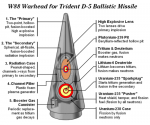470kg 535 is the original one designed for the oldest DF-31 and it was reportedly reduced to 360kg in 2000s to accommodate DF-5B & DF-41 MIRV capabilities.470kg 535 = 650kt
120kg 575 = 150kt
The 575 should be much more accurate than the 535 and city busters. The most important advantage for 575 is its light weight (similar to the W76 in US service), albeit the yield is relatively smaller compared to comparable warheads in service. In fact, I would imagine the core of the 575 being re-engineered fitted onto the DF-17 or the ALBM for the H-6 bombers, as soon as there's enough plutonium and gas. The 120kg weight (the spherical core probably weights less) also works for CJ-10 cruise missiles should the PLA consider developing a hypothetical "CJ-10H (H stands for nuclear)". Now these are all speculations.
515 warheads, deployed with JL-1/DF-21, is weighted 400kg only in its nuclear package, around 600kg in total with reentry vehicle. For comparison 515 is the 1st gen two stage thermonuclear design solid boosted in its primary core and 535 is supposed to be the 2nd gen and gas boosted in its core.
| Yield | Weight | |
| 515 Warhead | 700kt | 600kg |
| 535 Warhead | 650kt | 360kg |

